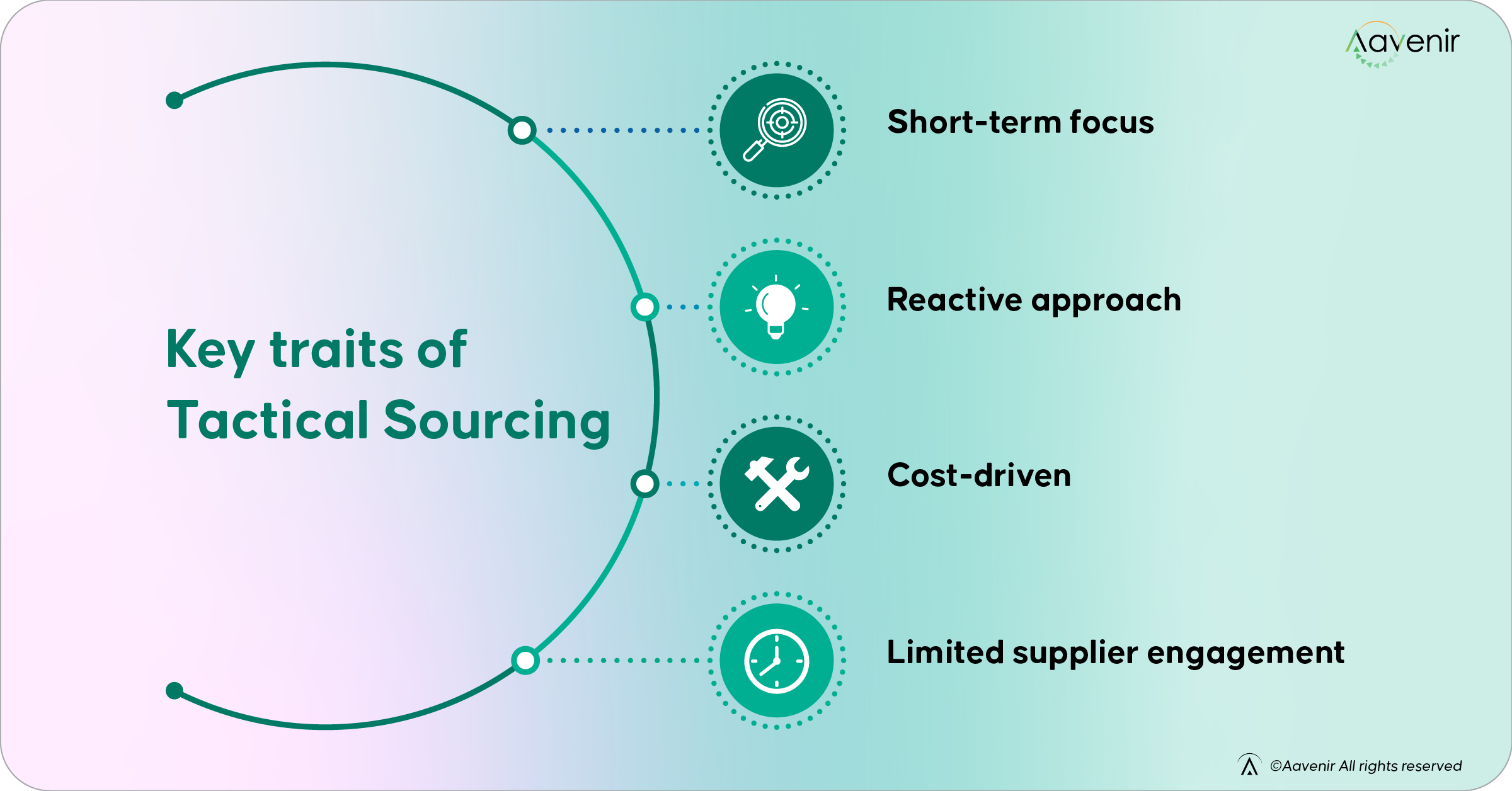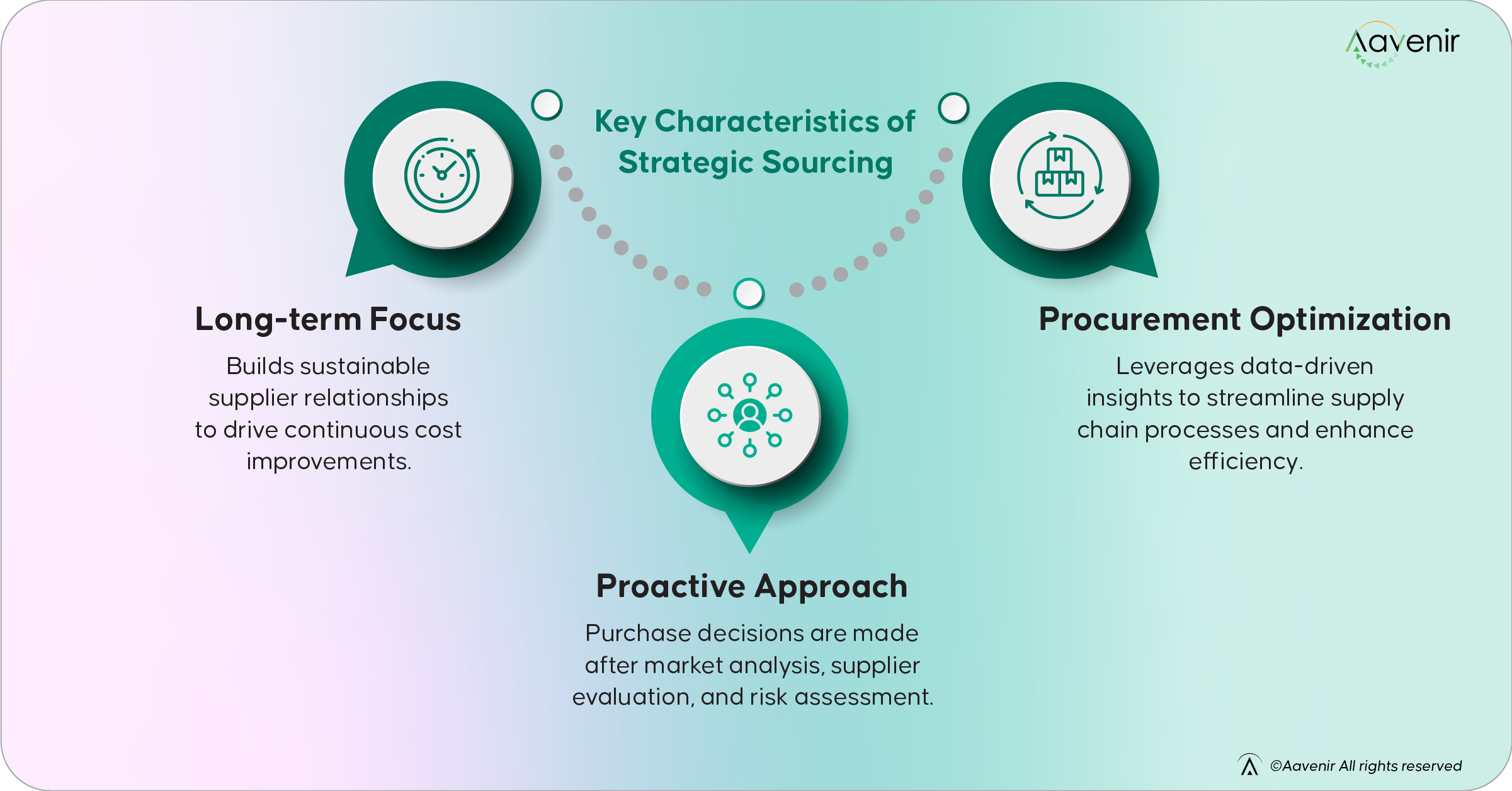It is critical to get procurement right.
According to the PwC Digital Procurement Survey (5th Edition), in 2024, 35% of 1000 businesses considered sourcing as their priority.
However, there are challenges. 40% of companies have reported rising sourcing costs due to inflation, supply chain disruptions, and increased demand for raw materials. Additionally, 95% of 3000 procurement decision-makers agree there is room to optimize their sourcing techniques.
Hence, organizations must adopt efficient procurement methodologies to acquire goods and services.
These methodologies fall into two primary categories: tactical sourcing and strategic sourcing.
While tactical sourcing focuses on short-term, transactional purchasing to meet immediate business needs, strategic sourcing emphasizes long-term supplier relationships, cost optimization, and risk mitigation.
Recognizing the distinction helps enterprise teams effectively manage tactical and strategic sourcing. Teams can minimize costs, enhance compliance, and quickly identify and resolve inefficiencies in supplier management.
This article will examine the key differences between tactical and strategic sourcing, the advantages of each approach, and how teams can effectively manage the relevant processes.
What is Tactical Sourcing?
Tactical sourcing is a short-term procurement strategy that fulfills an organization's transactional needs at the lowest possible resource expense. This approach to acquiring goods and services is ideal for non-critical purchases, where quick turnaround times and budget alignment are key.
The key traits of tactical sourcing include:
- Short-term focus: Addresses immediate business needs
- Reactive approach: Seeks suppliers after the needs are identified
- Cost-driven: Emphasis on optimizing financial resources
- Limited supplier engagement: Purchases are made from vendors without long-term contracts

Tactical sourcing is best suited for business situations when speed and flexibility are essential and long-term value considerations are relatively unimportant. Enterprises typically leverage tactical sourcing for these use cases:
- Emergency purchases: Securing critical materials in the event of supply chain disruptions or urgent organizational needs
- Low-risk, low-value items: Stationery supplies, MRO (maintenance, repair, and operations) products like janitorial equipment, and one-time purchases like furniture
- Shorter project timelines: Temporary projects, one-time campaigns, etc., can be rapidly completed when relevant raw materials are acquired via tactical sourcing
Some common examples of businesses using tactical sourcing include purchasing IT peripherals and securing cleaning supplies during an unforeseen shortage.
Remember that tactical sourcing is only effective for short-term needs. Relying solely on it will lead to missed cost-saving opportunities and supply chain inefficiencies.
Here are some examples of tactical sourcing across industries:
- BFSI (Banking, Financial Services, and Insurance): A bank purchasing office supplies, furniture, or temporary IT support for a new branch setup without long-term vendor agreements
- Healthcare: A hospital procuring emergency medical equipment or supplies (e.g., ventilators, PPE kits) during a sudden outbreak without strategic supplier contracts
- Manufacturing: A factory purchasing raw materials from spot markets due to an unexpected spike in demand instead of negotiating long-term bulk contracts
- IT (Information Technology): A company acquiring high-performance laptops for a new team through ad-hoc purchases instead of negotiating long-term deals with OEMs
- Telecom: A telecom provider sourcing network infrastructure component from multiple vendors for a quick expansion project rather than relying on strategic procurement
- Automotive: An automobile company buying spare parts from different suppliers due to urgent repair needs instead of engaging with a dedicated vendor
What is Strategic Sourcing?
Strategic sourcing is a long-term procurement strategy focusing on optimizing supplier selection, managing costs, and mitigating risks.
This acquisition method aligns with broader business objectives by emphasizing the total cost of ownership (TCO) rather than just prioritizing the cheapest deal.
Simply put, strategic sourcing directs the attention of procurement teams toward value creation, supplier performance, operational efficiency, and enterprise compliance.
The key characteristics of strategic sourcing include:
- Long-term focus: Builds sustainable supplier relationships to drive continuous cost improvements
- Proactive approach: Purchase decisions are made after market analysis, supplier evaluation, and risk assessment
- Procurement optimization: Leverages data-driven insights to streamline supply chain processes and enhance operational efficiency

Large businesses and corporations use strategic sourcing for complex, high-value, and high-risk acquisition scenarios such as:
- Managing high-value contracts: Strategic sourcing helps negotiate favorable terms, get volume discounts, and reduce long-term procurement expenses
- Ensuring compliance and quality control: Industries with strict regulations, such as aerospace and healthcare, need strategic sourcing to stay compliant and meet quality standards
- Reducing supply chain risks: Strategic sourcing can diversify suppliers, strengthen contractual safeguards, and audit procurement processes
For instance, a multinational company implements strategic sourcing for IT infrastructure investments, ensuring cost-effectiveness, equipment compliance, and vendor reliability over multiple years.
Similarly, pharmaceutical enterprises use this procurement approach to secure raw materials from certified suppliers to adhere to stringent safety and quality standards.
It is important to note that strategic sourcing is a time-intensive process. For example, tactical sourcing is more likely to meet the deadline if an organization needs to bolster its IT infrastructure within a few days.
Tactical Sourcing vs Strategic Sourcing: 6 Key Differences
Recognizing the key differences between procurement methods helps enterprise teams optimize acquisition costs, better manage supplier relationships, and ensure compliance, ultimately achieving supply chain resilience.
Let’s look at how tactical and strategic sourcing differ based on six key parameters:
| Parameter | Tactical Sourcing | Strategic Sourcing |
|---|---|---|
| Time Scale |
|
|
| Supplier Relationships |
|
|
| Decision-Making Approach |
|
|
| Cost Considerations |
|
|
| Quality and Innovation |
|
|
| Challenges |
|
|
Enterprise teams must balance both approaches to leverage the proper methodology in an appropriate setting to enhance procurement success.
How Aavenir Transforms Tactical and Strategic Procurement
Aavenir’s suite of AI-enabled solutions enables enterprise teams to seamlessly manage tactical and strategic procurement processes.
Aavenir RFPflow streamlines vendor assessment to facilitate faster vendor selection.
Its capabilities, such as automated proposal creation and distribution, bid evaluation and comparison, supplier prequalification, and savings tracking, help organizations accurately determine the best vendor.
Similarly, Aavenir Contractflow simplifies vendor negotiation, reducing the time it takes to sign vendor contracts and expediting vendor onboarding to streamline the source-to-contract processes.
Features such as pre-approved contract templates and clause libraries, AI-enabled contract review, eSignature, and custom approval workflows ensure enterprises hit the ground running as soon as they zero in on a vendor.
Aavenir’s Connected CLM empowers procurement teams by integrating Aavenir RFPflow and Aavenir Contractflow, enhancing agility, visibility, efficiency, and compliance.
It streamlines both tactical and strategic sourcing processes, enabling teams to quickly evaluate suppliers for urgent, short-term needs and manage long-term vendor relationships and contracts in a single platform.
Interested in learning how Aavenir can transform your procurement processes? Contact us today to book a demo.
Frequently Asked Questions
When to use strategic vs. tactical sourcing?
Use tactical sourcing for urgent, low-value, or one-time purchases requiring speed and cost efficiency. Opt for strategic sourcing for high-value, long-term supplier relationships focusing on cost optimization, risk management, and quality improvements.
What is the difference between tactical sourcing and strategic sourcing?
Tactical sourcing is short-term, reactive, and cost-driven, focusing on immediate procurement needs. Strategic sourcing is long-term, proactive, and value-focused, emphasizing supplier relationships, quality, and total cost of ownership.
When should procurement teams use tactical sourcing?
Procurement teams should use tactical sourcing for emergency purchases, low-risk items, and short-term projects where quick decision-making and immediate cost savings are more important than long-term supplier partnerships.
What are the advantages of strategic sourcing in procurement?
Strategic sourcing improves supplier collaboration, cost efficiency, compliance, and risk mitigation. Leveraging market insights and fostering strong supplier relationships ensures better quality, innovation, and long-term stability.
How can businesses balance tactical and strategic sourcing strategies?
Businesses should categorize procurement needs—using tactical sourcing for immediate, low-value needs and strategic sourcing for high-risk, long-term contracts. A hybrid approach helps optimize cost, quality, and efficiency.
What are some common challenges in implementing strategic sourcing?
Roadblocks during strategic sourcing include longer procurement cycles, higher resource investments, complex supplier management, and change resistance. Successful implementation requires stakeholder alignment, data-driven decision-making, and efficient contract management processes.


